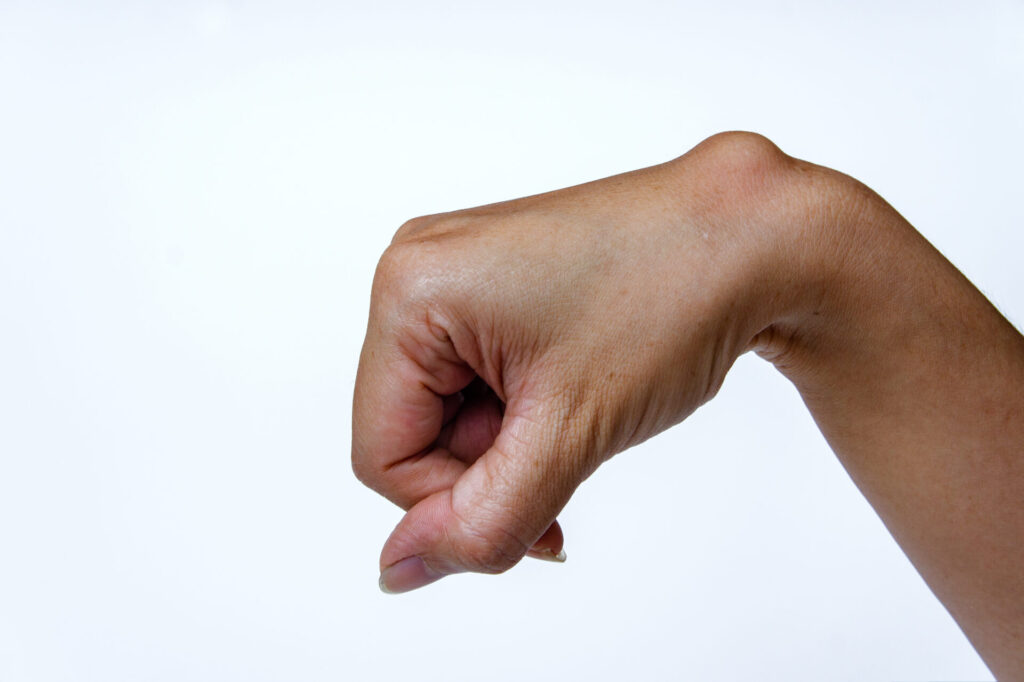What is a ganglion cyst?
A ganglion cyst is a harmless, sometimes painful, fluid-filled swelling which usually develops near a joint or tendon. They can vary in size from a pea to a golf ball. They consist of synovial fluid, the thick, gelatinous fluid which surrounds joints and tendons, and they feel and look like a smooth lump under the skin.
While they can occur next to any joint, they are especially common on the wrist, hand and fingers.
Ganglion cysts are harmless; however, they can sometimes be painful. If you do not experience pain, you may not wish to seek treatment and the cyst may disappear on its own, though it may take a long time to do so.
Treatment is only recommended if there is pain or if the ganglion cyst is affecting the movement of a joint – this may be available on the NHS but increasingly less so. You may also choose to have a ganglion cyst removed for cosmetic reasons. This would not be funded by the NHS.

Ready to book now? Get in touch to discuss your needs and decide on the best course of treatment for you.
Ready to book now? Get in touch to discuss your needs and decide on the best course of treatment for you.
What is ganglion cyst removal surgery?
Your consultant will explain your options and, after a physical examination, they will recommend the best course of treatment for you.
There are two main techniques for treatment: aspiration and surgical removal. The end goal for both techniques is to fully remove the cyst to relieve your symptoms. However, there is always a chance that the cyst may return. The likelihood of it returning varies from person to person and depends on the location of the cyst.
What happens during ganglion cyst removal surgery?
Your experience will depend on which type of procedure is recommended for your particular case. Your operation can often be carried out under local anaesthetic. It is a short procedure and you will usually go home on the same day.
Aspiration
Aspiration is an outpatient procedure and involves using a needle and syringe to remove synovial fluid from the ganglion cyst as possible. The area may also be injected with a steroid to reduce the changes of the cyst returning. This procedure is simple, painless and often the first treatment offered. Aspiration takes a matter of minutes. You’ll be able to go home immediately afterwards.
Surgical removal
Surgical removal can take two forms: open surgery where your surgeon makes a cut over the affected area, or arthroscopic (keyhole) surgery which uses an arthroscope as a guide. Both can be performed under either local or general anaesthetic. Depending on the technique used, surgical removal can take between 20 and 45 minutes.
Preparing for your surgery
Your surgeon will give you simple preparation advice to help you get ready for your operation.
You may be advised to stop taking medications a few days before surgery, particularly if you take aspirin or other blood-thinning drugs. If you smoke, you may be advised to stop. This is because smoking increases your chances of getting a wound infection, which can slow down your recovery after surgery.
It is advised that you prepare your home and living arrangements for your return from hospital. You may also need some extra help around the house too, so see if a friend or family member can stay with you to support.
Recovering from your surgery
Your hand and fingers may be swollen for the first few days. Most people need pain medicine for about a week after surgery.
If you have had a surgical removal, your wound will be stitched and bandaged. If surgery was performed on your hand or wrist than elevation and gentle movement of your hand will help swelling and aid healing.
What are the alternatives to surgery?
Treatment purely depends on the severity of the condition. Mild cases may not need any treatment.
Complications and side effects
Ganglion cyst removal is a minor operation and as such rarely has risks or complications. If you have had a surgical removal you may experience:
- Wound infection. This may require short course of antibiotics.
- Bruising, stiffness and swelling which may require physiotherapy.
- Damage to structures nearby such as nerves, blood vessels and tendons.
- Risks associated with general anaesthetic
- The recurrence of the ganglion cyst, which can be particularly high around the wrist.
Cost
Please call us to discuss pricing at your local clinic.
-
Carpal tunnel release surgery £1,375.00

